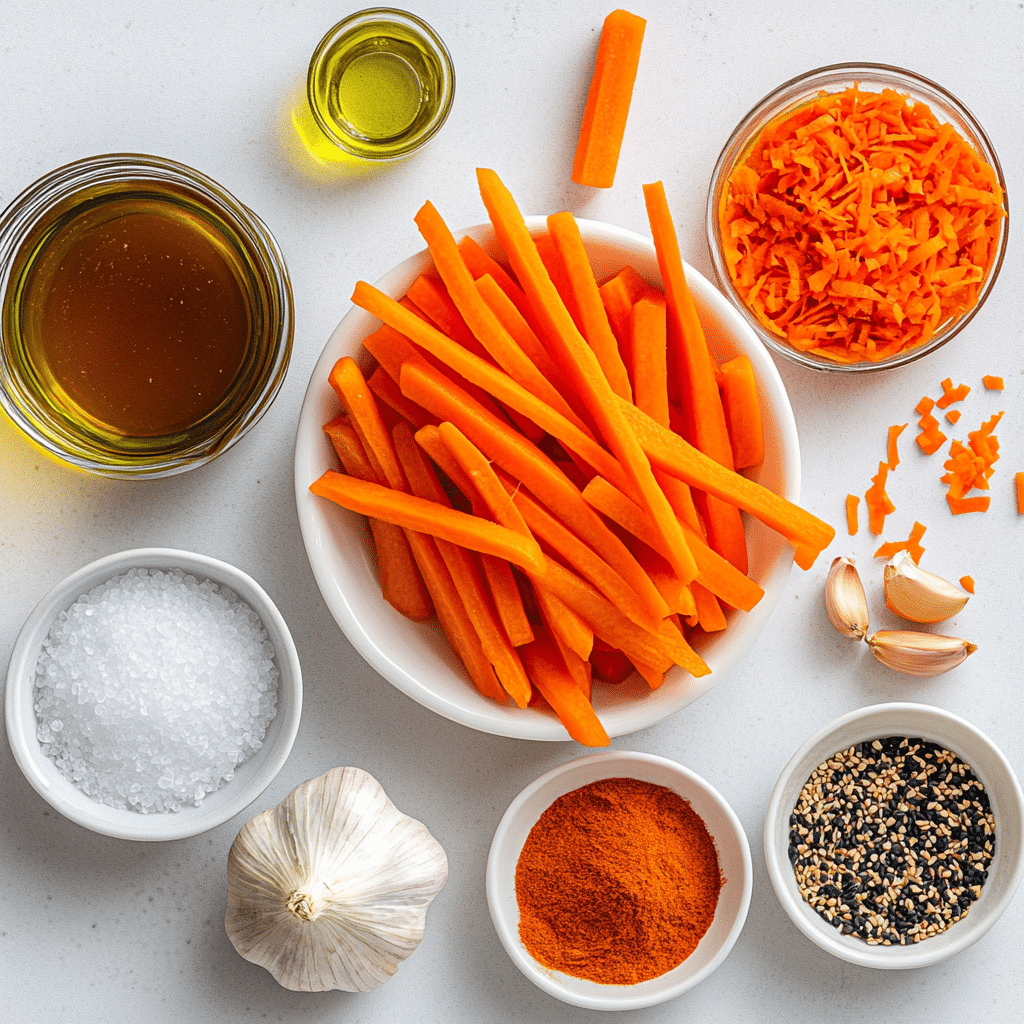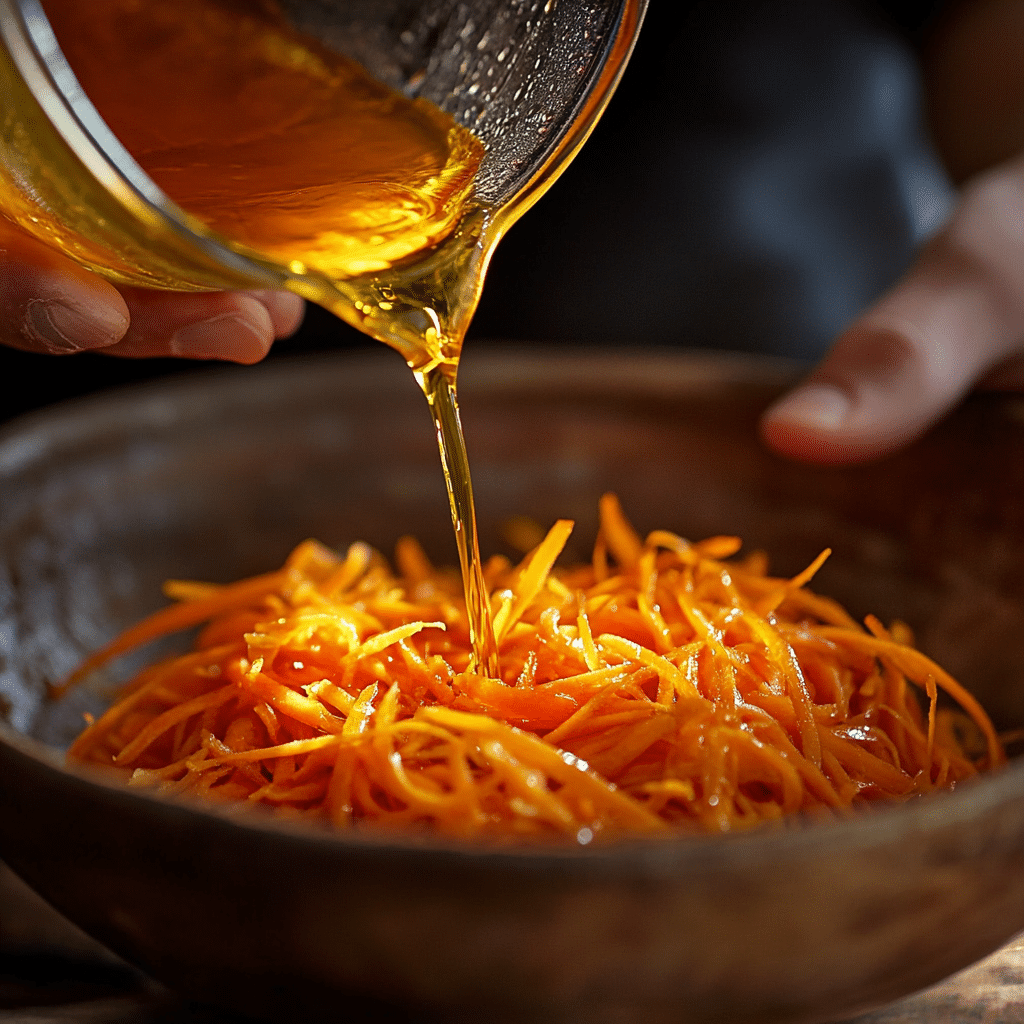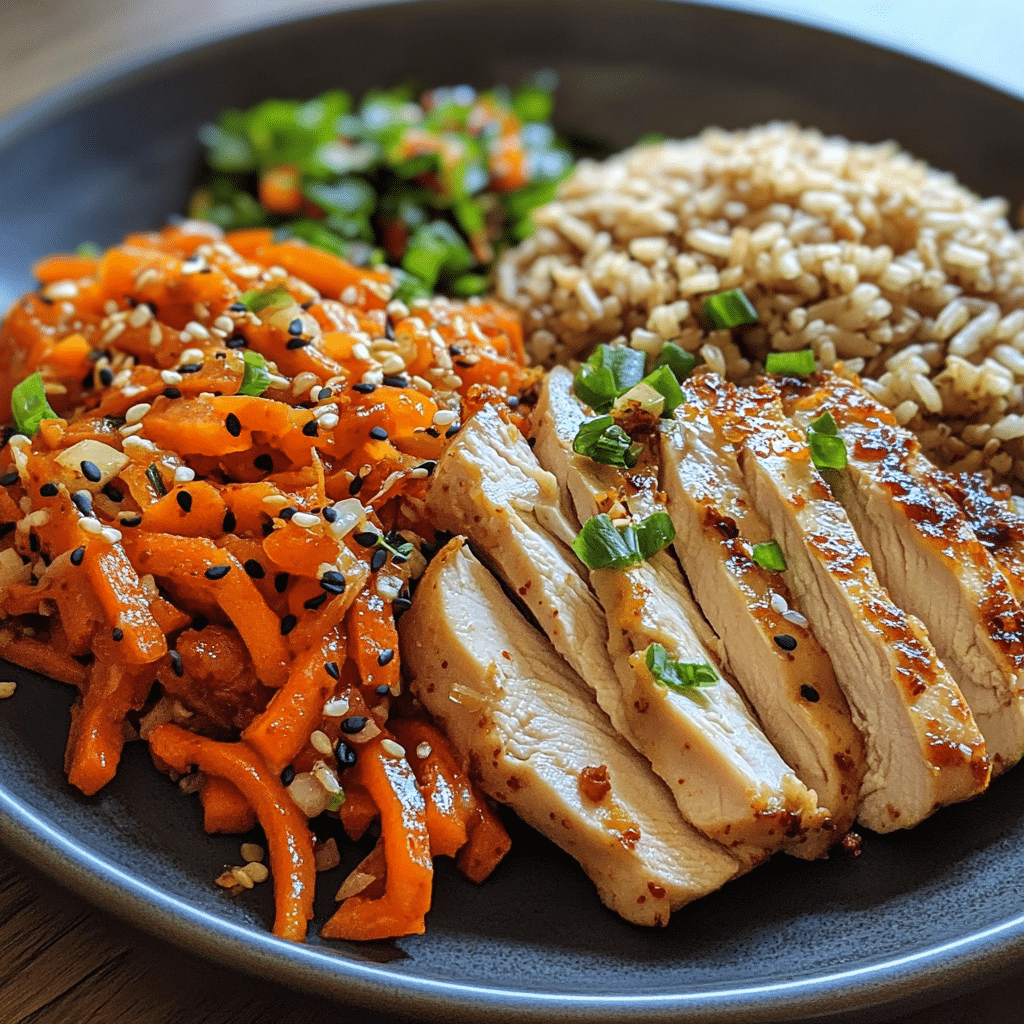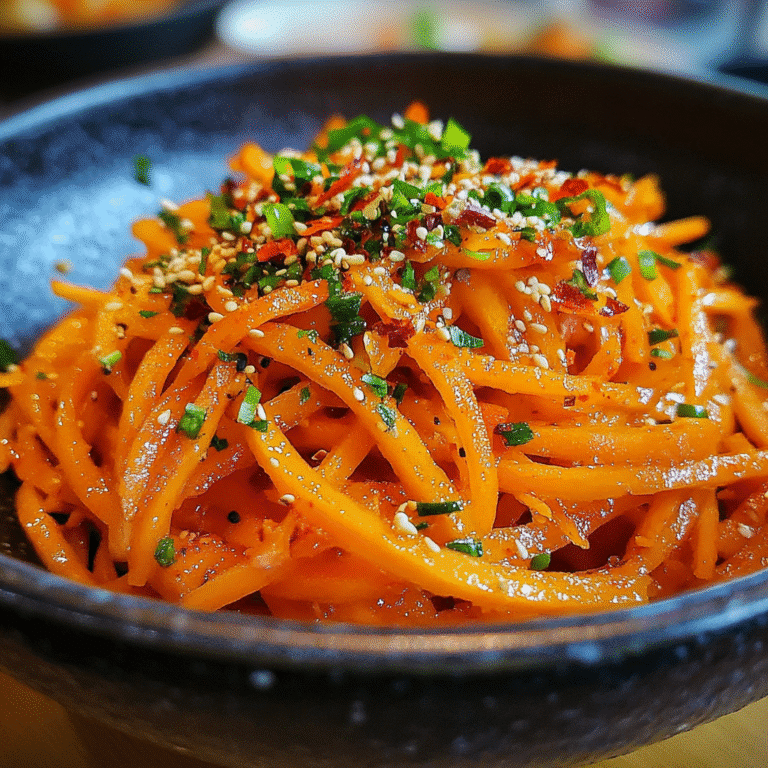Korean Carrot Salad is a spicy, garlicky, and crunchy dish that’s captured the hearts—and taste buds—of food lovers around the world. Despite what the name suggests, this carrot-based creation isn’t actually from Korea. Born out of the ingenuity of Korean immigrants living in the former Soviet Union, this flavorful salad combines bold seasoning with humble ingredients like fresh carrots, garlic, vinegar, and hot oil. As a culinary enthusiast, recipe developer, and flavor explorer behind Recipe by Clara, I’ve always been fascinated by dishes that blend cultures. Korean Carrot Salad is one of those rare gems that tells a story while exciting the palate.
Don’t miss our Instant Pot Beef Brisket Recipe for a protein-packed meal that pairs perfectly with this salad.
In this article, we’ll uncover the real history behind Korean Carrot Salad, explore its essential ingredients, discover what gives it that addictive spicy punch, and share ways to tweak it to suit your taste or dietary needs. Whether you’re a salad fan or someone who loves trying new international recipes, this one’s for you.
Table of Contents
Origins and History of Korean Carrot Salad
Is Korean Carrot Salad Actually Korean?
Despite the name, Korean Carrot Salad has no direct ties to South Korean cuisine. Instead, it originated among Koryo-saram—ethnic Koreans who lived in the former Soviet Union. These communities blended Korean techniques with available Soviet ingredients, eventually giving birth to this iconic dish.
During the mid-20th century, Koreans in Russia and Central Asia were limited in their access to traditional Korean vegetables like radish used in kimchi. So, they substituted carrots, which were plentiful. The result was this spicy, vinegary, and slightly sweet marinated salad we now call “Korean Carrot Salad.” It’s more Soviet-Korean than traditionally Korean.
The Soviet-Korean Culinary Fusion
This dish reflects a broader theme of cultural adaptation. Koryo-saram used spices they had brought from Korea but adjusted the heat and texture to suit Slavic palates. The dish quickly spread across Russia, Ukraine, Kazakhstan, and beyond. Over the years, it has become a staple at festive tables, sold at delis, and shared across generations.
Looking for inspiration? Try our Traditional Mexican Breakfast Food to explore another story-rich cuisine that blends roots and flavors.
The name “Korean Carrot Salad” stuck—not because it came from Korea—but because it was made by Koreans. Today, the dish continues to evolve, sometimes garnished with sesame seeds, cilantro, or even a dash of soy sauce, depending on where and who’s preparing it.
Traditional Ingredients Breakdown
What Is Korean Carrot Salad Made Of?
At its core, Korean Carrot Salad is a simple yet deeply flavorful dish. It’s made from everyday ingredients found in most kitchens, yet when combined, they produce a surprisingly addictive flavor. The standard recipe includes:
| Ingredient | Purpose in the Dish |
|---|---|
| Carrots (julienned) | Base ingredient, provides crunch and sweetness |
| Garlic (crushed/minced) | Adds pungent depth and authentic bite |
| Vegetable Oil | Used to infuse and distribute flavor |
| Vinegar (usually white or apple cider) | Offers acidity and balance |
| Sugar | Balances spice and acidity |
| Salt | Enhances all other flavors |
| Ground coriander | Signature earthy, citrusy note |
| Chili powder or flakes | Creates the iconic heat and color |

These ingredients are common, but their combination is what makes the dish shine. It’s not just a salad—it’s a flavor explosion with roots in resourceful cuisine-building.
Check out our Mexican Elote Recipe for another smart mix of humble ingredients with bold flavor.
Role of Carrots, Garlic, and Oil in Texture and Taste
Carrots are shredded into fine julienne strips, allowing them to absorb flavors without losing their crunch. They’re not just a filler—carrots provide natural sweetness that balances the salad’s heat and acidity. The thinner the slices, the better the flavor absorption.
Garlic is crucial. Raw and freshly minced garlic gives the salad its bold, unapologetic kick. Some recipes even temper the garlic by briefly sautéing it in oil, but the raw version delivers the strongest bite.
Hot oil plays a game-changing role. Rather than tossing in raw spices, traditional Korean Carrot Salad recipes pour heated oil directly over the garlic and spices. This blooming technique releases aromatic oils from the coriander and chili flakes, making the seasoning taste richer and more infused.
Don’t miss our Creamy Cheese Chicken Pasta—its smooth richness is a great contrast to the sharp flavors of this salad.
You may also come across additions like onions, sesame seeds, or soy sauce in newer versions of the recipe. But these are typically modern fusions, and while they add interesting depth, they’re not found in the classic version.
Flavor Profile and Seasoning Techniques
What Makes Korean Carrot Salad Spicy?
The signature spice of Korean Carrot Salad comes from a clever and flavorful technique: pouring hot oil over dry seasonings like chili flakes, coriander, and sometimes black pepper. This process “blooms” the spices—activating their essential oils and intensifying both flavor and aroma.
Let’s break it down:
- Chili Flakes or Powder: Most authentic recipes use coarsely ground red chili flakes. These are poured over with hot oil, giving the salad a deep, smoky warmth—not just surface-level heat. If you want less heat, try sweet paprika or Korean gochugaru.
- Fresh Garlic: The sharpness of raw garlic contributes a powerful “spice” that’s different from chili heat. It hits the back of your throat and enhances the salad’s bold character.
- Coriander Powder: Though not spicy in the traditional sense, it adds warmth and earthy depth, working as a flavor balancer.
Discover great ideas like Salsa Negra if you’re into bold, spicy condiments made with oil and deep flavors.
The level of spiciness is completely adjustable. Here are some quick spice-control tips:
| Preference | Adjustment |
|---|---|
| Mild | Use less chili and more sugar or vinegar |
| Medium | Stick to standard chili flake amount |
| Hot | Add extra chili, or mix in cayenne or pepper oil |
Balancing Sweet, Tangy, and Spicy Notes
A good Korean Carrot Salad doesn’t just burn—it balances. The interplay of sweetness (from sugar and carrots), sourness (from vinegar), saltiness (from seasoning), and spiciness (from chili and garlic) is what makes it crave-worthy.
- Sugar: Typically white or cane sugar, it softens the vinegar’s sharpness and smooths out the chili heat.
- Vinegar: White vinegar is traditional, but apple cider or rice vinegar can be used for a fruitier flavor. It brightens the entire dish.
- Salt: Amplifies all other flavors. Coarse salt works well for releasing water from the carrots.
The salad is usually left to marinate for a few hours—or overnight—so all flavors deepen and meld. The result? A perfectly seasoned, zippy, addictive dish with just the right kick.
How to Make Korean Carrot Salad at Home
Step-by-Step Traditional Recipe
Creating authentic Korean Carrot Salad at home is easier than you think, and you don’t need any fancy tools—just a sharp knife or julienne peeler, a hot pan, and some patience for marination.
Here’s a tried-and-true traditional recipe you can follow:
Ingredients
| Ingredient | Quantity |
|---|---|
| Carrots (large) | 4-5, peeled and julienned |
| Garlic | 3-4 cloves, minced |
| Vinegar | 3 tbsp |
| Sugar | 1½ tbsp |
| Salt | 1 tsp |
| Ground coriander | 1 tsp |
| Chili flakes | 1 tsp (adjust to taste) |
| Vegetable oil | 4 tbsp (neutral, like sunflower or canola) |
Instructions
- Prepare the carrots
Julienne the carrots into thin, even strips. The thinner, the better—they soak up flavor more quickly. - Salt and rest
Add the salt and gently massage the carrots to draw out excess moisture. Let it sit for 10–15 minutes, then drain if necessary. - Mix the seasonings
In a large bowl, add garlic, sugar, coriander, vinegar, and chili flakes to the carrots. Mix well. - Infuse with hot oil
Heat the oil in a small pan until just shimmering. Carefully pour it over the seasoned carrot mix. You should hear a sizzle. Mix immediately to evenly coat. - Marinate
Cover and refrigerate for at least 3 hours—overnight is ideal for maximum flavor.
Looking for a fresh bite to pair with this salad? Try our Cloud Bread Breakfast Sandwich for a high-protein, low-carb match.

Tips to Slice and Marinate Carrots Perfectly
- Use a mandoline or julienne peeler for uniform slices. If chopping by hand, aim for very thin, matchstick-sized pieces.
- Massage the carrots gently with salt to soften them slightly while keeping crunch.
- Avoid overcooking the oil—it should be hot, not smoking. If it burns the spices, it’ll turn bitter.
- For deeper flavor, some add a pinch of ground cumin or a drop of soy sauce—but these are modern tweaks.
Once marinated, the salad will keep in the fridge for up to 5 days, making it a great make-ahead side dish.
Variations and Substitutes
Can You Make Korean Carrot Salad Without Vinegar?
Yes, you absolutely can make Korean Carrot Salad without vinegar—and the good news is it still tastes amazing. If you’re sensitive to vinegar or simply don’t have it on hand, try these alternatives:
| Vinegar Substitute | Effect on Flavor |
|---|---|
| Fresh lemon juice | Adds brightness with a fruity tang |
| Rice vinegar | Milder and slightly sweet, ideal substitute |
| Lime juice | Zesty and fresh, but stronger than lemon |
| White wine vinegar | Close match but more refined acidity |
Pro Tip: When skipping vinegar entirely, increase the garlic and chili slightly to preserve that bold punch. Also, reduce sugar by half to avoid imbalance.
Don’t miss our Banana Coffee Syrup—a sweet, natural twist you can pair with many spicy meals for contrast.
Low-Spice, Vinegar-Free, or Vegan-Friendly Options
Korean Carrot Salad is naturally vegan and gluten-free, but you can still customize it further:
Low-Spice Version
- Use sweet paprika instead of chili flakes.
- Add a touch more sugar to mellow the flavor.
- Skip the garlic or sauté it gently for a softer taste.
No Vinegar, No Problem
- Use a mix of lemon juice and a pinch of mustard for tang.
- Skip acid altogether and lean on herbs like cilantro for freshness.
Add-Ons and Creative Variants
| Add-In | Flavor Profile |
|---|---|
| Toasted sesame seeds | Nutty crunch and visual appeal |
| Chopped cilantro | Fresh, herbal brightness |
| Sliced onions | Sweet-sharp bite that complements carrots |
| Soy sauce or tamari | Umami boost, especially in modern variants |
| Roasted peanuts or cashews | Crunchy, protein-rich additions |
These tweaks allow you to make this salad fit your dietary needs, pantry items, or just your mood.
Check out our Cottage Cheese Banana Bread for a high-protein side that balances this salad’s spice beautifully.
Nutritional Value and Health Benefits
Is Korean Carrot Salad Good for You?
Absolutely. Korean Carrot Salad isn’t just delicious—it’s packed with nutrients and low in calories, making it an excellent side or snack for health-conscious eaters.
Here’s a breakdown of the nutritional value per 1-cup (150g) serving:
| Nutrient | Approximate Value |
|---|---|
| Calories | 120–150 kcal |
| Carbohydrates | 10–14g |
| Sugars (natural + added) | 5g |
| Fiber | 3–4g |
| Fats (mostly from oil) | 8–10g |
| Protein | 1–2g |
| Sodium | Moderate (adjustable) |
It’s naturally gluten-free, vegan, and dairy-free. Thanks to its use of raw carrots, the salad is also:
- Rich in beta-carotene, which supports eye health and immunity.
- High in fiber, aiding digestion and satiety.
- Full of antioxidants, from garlic and spices that fight inflammation.
Looking for a cozy, gut-friendly pairing? Try our Sourdough Discard Soda Bread alongside this salad for a fiber-rich, nourishing meal.
Calories, Fiber, and Antioxidant Benefits
Carrots are low in calories but rich in vitamin A, vitamin K1, potassium, and biotin. Garlic, though used in small amounts, has proven antibacterial and immune-boosting properties.
The heated oil technique may slightly increase the fat content, but it also helps your body better absorb fat-soluble vitamins like A and E from the carrots.
Plus, Korean Carrot Salad fits well into diets like:
- Whole30 (with no sugar)
- Paleo (with clean oil and vinegar)
- Low-carb (with moderate sugar substitution)

Whether you’re trying to eat cleaner or just enjoy something flavorful without guilt, this salad checks all the boxes.
Conclusion
Korean Carrot Salad may not be Korean in origin, but it’s rich in flavor, history, and versatility. With just a few simple ingredients, you can create a side dish that’s bold, spicy, slightly sweet, and wonderfully crunchy. Whether you’re meal-prepping for the week, looking to impress with an international appetizer, or simply trying something new, this salad deserves a place in your kitchen.
Don’t miss our Chickpea and Spinach Curry for another nutritious, globally inspired dish that complements this carrot salad perfectly.
FAQs About Korean Carrot Salad
What is Korean carrot salad made of?
It’s made from finely julienned carrots, fresh garlic, vinegar, sugar, salt, coriander, chili flakes, and vegetable oil. These ingredients are mixed and marinated to create a sweet, spicy, and tangy flavor.
Is Korean carrot salad actually Korean?
No. Despite the name, it was created by ethnic Koreans living in the Soviet Union. It’s more of a Soviet-Korean fusion dish than a traditional Korean recipe.
What makes Korean carrot salad spicy?
The spiciness comes from chili flakes that are bloomed in hot oil and poured over the salad. Fresh garlic also adds a sharp, spicy bite.
Can you make Korean carrot salad without vinegar?
Yes. You can use lemon juice, lime juice, or even rice vinegar as substitutes. Some versions skip vinegar altogether and adjust with other acidic or aromatic ingredients.

